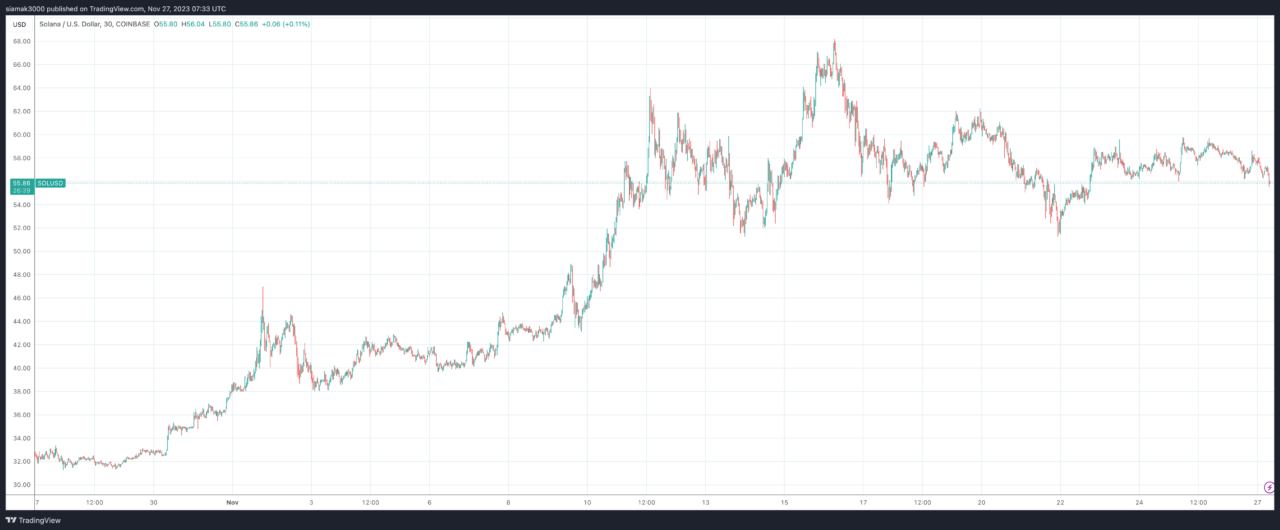
$SOL: Solana's Market Rebound Predicted to Eclipse $80, Analyst Predicts
November 27, 2023Popular pseudonymous crypto analyst Bluntz recently unveiled a compelling forecast for Solana (SOL), suggesting a robust recovery and an upward trajectory. In a recent YouTube video, he said that SOL, which is the native token of Solana, a formidable Ethereum (ETH) competitor, is on the cusp of a significant rally.
Bluntz’s analysis hinges on the Elliott Wave theory, which is a method of technical analysis used in trading that was developed by Ralph Nelson Elliott in the 1930s. It is based on the idea that financial markets move in repetitive cycles, which are influenced by investor psychology and external factors. The theory suggests that market prices unfold in specific patterns, referred to as “waves,” which can be identified and used to predict future market trends.
Here’s a breakdown of the key components of Elliott Wave Theory:
- Wave Patterns: Elliott identified that price movements in financial markets generally follow a natural rhythm of five waves in the direction of the prevailing trend, followed by three corrective waves. This 5-3 wave pattern is considered a complete cycle.
- Impulse Waves: The five-wave pattern includes three ‘impulse’ waves (numbered 1, 3, and 5) and two ‘corrective’ waves (numbered 2 and 4). Impulse waves move in the direction of the overall trend, while corrective waves move against it.
- Corrective Waves: After the five-wave impulse sequence, a three-wave corrective sequence typically follows, labeled as A, B, and C. These waves correct and retrace a portion of the progress made by the preceding impulse waves.
- Fractal Nature: Elliott Wave patterns are fractal, meaning they can be observed at increasingly smaller scales. This fractal nature implies that the same patterns can be identified in long-term historical charts as well as short-term intraday charts.
- Predictive Value: Traders and analysts use Elliott Wave Theory to attempt to forecast future price movements by identifying the start and end of wave patterns. By understanding where they are in the wave sequence, they can make predictions about where the price is likely to go next.
- Investor Psychology: The theory also incorporates elements of crowd psychology, as it assumes that traders collectively move between optimism and pessimism in natural sequences.
Elliott Wave Theory is widely used in the trading community, but it’s important to note that, like all forms of technical analysis, it’s not foolproof. Its subjective nature means that different analysts might interpret wave patterns differently. Therefore, it’s often used in conjunction with other forms of analysis to strengthen trading strategies.
Bluntz highlighted that Solana has emerged from its corrective phase, a pivotal moment signaling a potential surge. Bluntz identified a distinct pattern in Solana’s recent price movements. He observed an initial five-wave ascent, indicative of bullish momentum, followed by a minor ABC correction. This pattern, he suggests, marks the end of Solana’s price dip and the beginning of a new growth phase.
In the broader crypto race, Bluntz envisions Solana as a frontrunner, potentially outpacing others in the upcoming market cycle. His analysis of the SOL/BTC pair further bolsters this view, hinting at Solana’s strengthening position. While Bluntz’s immediate target for Solana hovers above the $80 mark, he hints at a trajectory that could soar much higher. He anticipates a pattern of reaching new highs, interspersed with brief pullbacks, before reaching a zenith. Bluntz’s bullish stance is not short-lived. He foresees this upward trend persisting until a complete five-wave cycle unfolds, starting from the initial wave. He plans to reassess his perspective once this cycle culminates, but for now, he sees a robust growth path for Solana.
https://youtube.com/watch?v=dcXGFBMjz9g%3Ffeature%3Doembed
At the time of writing, SOL is trading at around $55.94, down 3.24% in the past 24-hour period.
Featured Image via Pixabay
Source: Read Full Article



